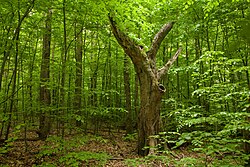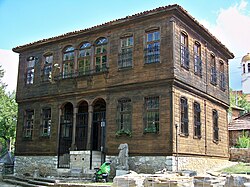Strandzha (Bulgarian: Странджа, also romanized Stranja, Strandja and Strandza) is a low mountain in the south-eastern corner of Bulgaria, straddling the border with Turkey and reaching the Black Sea to the east. On the Bulgarian side, most of it is included in Nature Park Strandzha, the largest protected natural area in the country.
Understand
[edit]


The "dzh" (дж) in the name is pronounced like j in "jump" - STRAN-jah.
Geographically, more than half of Strandzha is on the Turkish side of the border, in Eastern Thrace, including its main ridge and the highest peak, Mahya Dağı (1,031 m (3,383 ft) above sea level). On the Bulgarian side, the highest is Gradishte, at 709 m (2,326 ft). Unsurprisingly, Bulgarian Strandzha is a low and spread-out mountain covered with trees. The Veleka river runs a meandering course through the slopes, roughly west to east, flowing into the Black Sea close to Sinemorets. Its mouth, with its recognisable sand bar, is a protected area and a tourist attraction.
In Bulgaria, Strandzha is known for the distinctive 19th century architecture that can be observed in Malko Tarnovo, Brashlyan and many other villages, its rich folklore, and traditions such as nestinarstvo (barefoot dancing on live embers) that preserve numerous pagan elements. Strandzha is an area with a large concentration of ruins of Thracian sanctuaries and sacrificial altars, dolmens and other archaeological objects. The mountain is also the home of the Strandzha Nature Park - the largest in Bulgaria, incorporating five nature reserves, fourteen other protected areas and eight natural landmarks.
Towns and villages
[edit]- 1 Malko Tarnovo (Малко Търново) - a small town with a permanent population of slightly less than 2000 people (2023), the largest in Strandzha proper. The name means "Small Tarnovo", to distringuish it from "Great Tarnovo" in the north of Bulgaria.
Get in
[edit]European route E87 leads from Turkey to Burgas before heading north along the coast towards Romania and Ukraine. It crosses the border at the Dereköy/Malko Tarnovo checkpoint.
Get around
[edit]The two largest roads in the area are national roads 9 and 99. Road 9 is part of E87 and runs directly north from the border crossing to Burgas, the second largest city on the Bulgarian coast. The secondary Road 99 splits off Road 9 at Malko Tarnovo and follows a more easterly course, leaving Nature Park Strandzha to reach the sea at Tsarevo and then runs north/north-west along the coast to rejoin Road 9 just south of Burgas.
See
[edit]Do
[edit]Eat
[edit]Drink
[edit]Stay safe
[edit]Go next
[edit]To the southeast, the mountain range extends into the Turkish region of Eastern Thrace, where it is known as Istranca. See the articles for Demirköy, İğneada, Vize, Kıyıköy, Saray, and Çatalca for the relevant sites in the Turkish portion.
